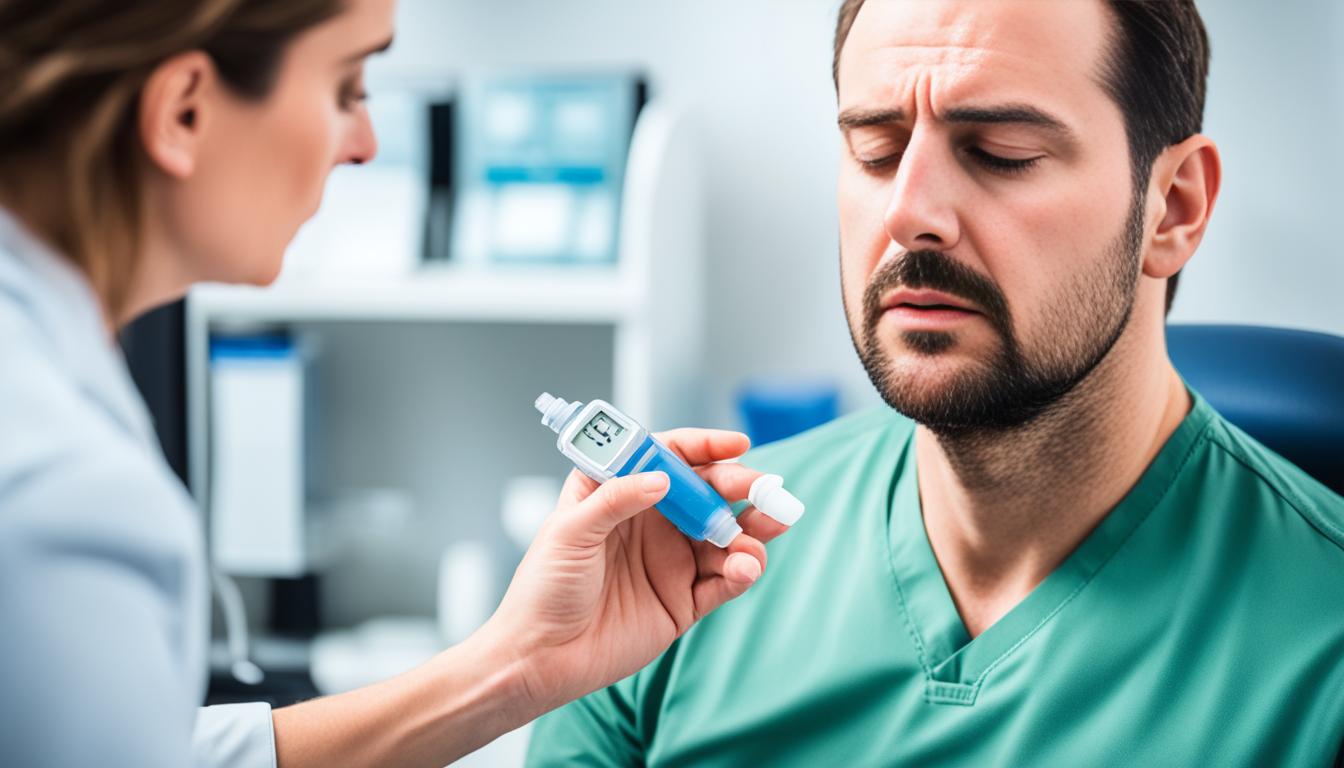Ketoacidosis is a serious condition in diabetes called diabetic ketoacidosis (DKA). It happens when there’s too many ketones in the blood and the body becomes too acidic. People with type 1 diabetes are mostly affected, but type 2 diabetes individuals can also suffer. It’s caused by not enough insulin, the body’s resistance to insulin, and high blood sugar.
DKA signs can be feeling very thirsty, needing to pee a lot, and feeling sick. You might also have a stomach ache, breathe out a sweet smell, and not think clearly. Getting quick help is important to avoid serious problems or death.
To diagnose DKA, doctors look at your symptoms and do blood tests to check your sugar and ketone levels. They might also analyze your blood gas. Treating DKA means getting fluids through a vein, taking insulin, and balancing your body’s minerals.
Key Takeaways:
- DKA is a serious complication of diabetes characterized by high ketone levels and acidosis.
- It primarily affects individuals with type 1 diabetes but can also occur in type 2 diabetes.
- Insufficient insulin, increased insulin resistance, and elevated blood sugar levels are common causes.
- Early diagnosis and prompt treatment are essential to prevent complications and life-threatening outcomes.
- Intravenous fluid replacement, insulin administration, and electrolyte correction are the mainstay treatment for DKA.
- Stem cell therapy shows promise as a potential treatment for DKA, improving beta-cell function and insulin production.
- More research is needed to establish the long-term safety and efficacy of stem cell therapy for DKA.
Symptoms of Diabetic Ketoacidosis
Diabetic ketoacidosis (DKA) is a severe complication that can happen fast in diabetics. Knowing its symptoms is key to detect and treat it early. Here are the main signs to look for:
- Excessive thirst: A great need for water is a top symptom in DKA.
- Frequent urination: You might pee more often as your body tries to get rid of extra sugar and ketones.
- Unexplained weight loss: Losing weight quickly happens as the body breaks down fat for energy.
- Fatigue: Feeling tired and weak is common because the body can’t use glucose well.
- Blurred vision: High blood sugar can make your vision blurry.
- Nausea and vomiting: Feeling sick to your stomach and throwing up often occur in DKA.
- Abdominal pain: Sharp or cramp-like belly pain might be felt by some in DKA.
- Fruity-smelling breath: Breath that smells sweet or like nail polish remover is a unique DKA sign.
- Rapid and deep breathing: Overly fast and deep breaths are the body’s way of trying to get rid of acids.
- Confusion: Feeling mixed up or having trouble thinking is another warning sign.
- Unconsciousness: DKA can get so bad that someone might pass out or go into a coma.
Seeing these symptoms means you need to act fast. DKA is a big health emergency. It requires quick treatment to stop deadly issues from happening.
Causes and Risk Factors of Diabetic Ketoacidosis
Diabetic ketoacidosis (DKA) happens when the body lacks insulin. This could be because someone misses their insulin doses. Without enough insulin, the body can’t use glucose for energy. Instead, it breaks down fat, forming ketones in the blood.
DKA isn’t caused only by missed doses. Infections and other illnesses can also play a part. They increase insulin resistance and push stress hormones that break down stored glucose.
Stress, both physical and emotional, can lead to DKA, too. It interferes with how insulin works. Certain drugs, like corticosteroids, and health issues such as pancreatic diseases can make DKA more likely.
Children and teenagers are at a higher risk for DKA. This is because their bodies are changing quickly. They may also find it harder to manage their diabetes than adults.
Bad diabetes management can really up the DKA risk. This includes not taking insulin regularly and not monitoring blood sugar well. Also, not having easy access to healthcare or being in a tough economic spot can make things harder.
Preventing DKA means managing diabetes properly. This includes checking blood sugar often, taking medication as prescribed, and seeking help fast if DKA signs show up. Living healthy – with good food, exercise, and stress management – is also key.
Ketoacidosis Causes and Risk Factors Table:
| Causes of Ketoacidosis | Risk Factors for DKA |
|---|---|
| Missed or inadequate insulin doses | Younger age |
| Infection | Type 1 diabetes |
| Illness or injury | Poor diabetes management |
| Emotional or physical stress | Lack of access to healthcare |
| Certain medications | Socioeconomic factors |
| Underlying medical conditions |
Image: A visual representation of the causes and risk factors for diabetic ketoacidosis.
Stem Cell Therapy for Diabetic Ketoacidosis
Stem cell therapy is now a hopeful way to treat diabetic ketoacidosis (DKA). Studies show that stem cells, like mesenchymal and hematopoietic types, can help a lot. They make the beta cells work better, increase insulin, and balance the immune system. These cells come from bone marrow, fat, and umbilical cord blood.
Transplanting stem cells, either from the patient or a matched donor, can do much. It can improve blood sugar, lower the need for insulin, and reduce DKA risks. This new way to treat DKA brings hope to those not helped by usual methods.
But, using stem cells for DKA is still being studied. We need to know if it’s really safe and works well for a long time. If it turns out positive, stem cell therapy might be a new or extra treatment for DKA. This could help with its management and the overall health of those with the condition.

